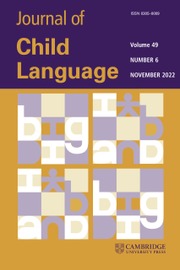Crossref Citations
This article has been cited by the following publications. This list is generated based on data provided by
Crossref.
Lewis, Charlie
and
Gregory, Susan
1987.
Parents'talk to their infants: the importance of context.
First Language,
Vol. 7,
Issue. 21,
p.
201.
O'Brien, Marion
Johnson, Jeanne M.
and
Anderson-Goetz, Diana
1989.
Evaluating quality in mother-infant interaction: Situational effects.
Infant Behavior and Development,
Vol. 12,
Issue. 4,
p.
451.
Piel, John A.
1990.
Unmasking Sex and Social Class Differences in Childhood Aggression: The Case for Language Maturity.
The Journal of Educational Research,
Vol. 84,
Issue. 2,
p.
100.
Hoff-Ginsberg, Erika
1991.
Mother-Child Conversation in Different Social Classes and Communicative Settings.
Child Development,
Vol. 62,
Issue. 4,
p.
782.
O’Brien, Marion
1992.
Handbook of Social Development.
p.
325.
O'Brien, Marion
and
Bi, Xiufen
1995.
Language Learning in Context.
Topics in Early Childhood Special Education,
Vol. 15,
Issue. 2,
p.
148.
Walker, K
and
Armstrong, L
1995.
Do mothers and fathers interact differently with their child or is it the situation which matters?.
Child: Care, Health and Development,
Vol. 21,
Issue. 3,
p.
161.
Young-Loveridge, Jennifer M.
1996.
The Number Language used by Preschool Children and their Mothers in the Context of Cooking.
Australasian Journal of Early Childhood,
Vol. 21,
Issue. 1,
p.
16.
Lewis, Charlie
Kier, Cheryl
Hyder, Christina
Prenderville, Nancy
Pullen, Judith
and
Stephens, Annabella
1996.
Observer Influences on Fathers and Mothers: An Experimental Manipulation of the Structure and Function of Parent – Infant Conversation.
Early Development and Parenting,
Vol. 5,
Issue. 1,
p.
57.
Leyendecker, Birgit
Lamb, Michael E.
and
Schölmerich, Axel
1997.
Studying mother-infant interaction: The effects of context and length of observation in two subcultural groups.
Infant Behavior and Development,
Vol. 20,
Issue. 3,
p.
325.
Tenenbaum, Harriet R.
and
Leaper, Campbell
1997.
Mothers' and Fathers' Questions to Their Child in Mexican-Descent Families: Moderators of Cognitive Demand During Play.
Hispanic Journal of Behavioral Sciences,
Vol. 19,
Issue. 3,
p.
318.
Leyendecker, Birgit
Lamb, Michael E.
Schölmerich, Axel
and
Fricke, Delia Miranda
1997.
Contexts as Moderators of Observed Interactions: A study of Costa Rican Mothers and Infants from Differing Socioeconomic Backgrounds.
International Journal of Behavioral Development,
Vol. 21,
Issue. 1,
p.
15.
Bornstein, Marc H.
and
Haynes, O. Maurice
1998.
Vocabulary Competence in Early Childhood: Measurement, Latent Construct, and Predictive Validity.
Child Development,
Vol. 69,
Issue. 3,
p.
654.
Bornstein, Marc H.
and
Haynes, O. Maurice
1998.
Vocabulary Competence in Early Childhood: Measurement, Latent Construct, and Predictive Validity.
Child Development,
Vol. 69,
Issue. 3,
p.
654.
Paul, Rhea
and
Marans, Wendy D.
1999.
Assessing Speech, Language, and Communication.
Child and Adolescent Psychiatric Clinics of North America,
Vol. 8,
Issue. 2,
p.
297.
Leaper, Campbell
2000.
Gender, affiliation, assertion, and the interactive context of parent–child play..
Developmental Psychology,
Vol. 36,
Issue. 3,
p.
381.
Girolametto, Luigi
Hoaken, Lisa
Weitzman, Elaine
and
Lieshout, Riet van
2000.
Patterns of Adult-Child Linguistic Interaction in Integrated Day Care Groups.
Language, Speech, and Hearing Services in Schools,
Vol. 31,
Issue. 2,
p.
155.
Galloway, Ann
2000.
Some characteristics of fathers’ and mothers’ speech to young children.
Australian Review of Applied Linguistics,
Vol. 23,
Issue. 1,
p.
53.
Girolametto, Luigi
Weitzman, Elaine
Lieshout, Riet van
and
Duff, Dawna
2000.
Directiveness in Teachers' Language Input to Toddlers and Preschoolers in Day Care.
Journal of Speech, Language, and Hearing Research,
Vol. 43,
Issue. 5,
p.
1101.
Lindsey, Eric W.
and
Mize, Jacquelyn
2001.
Contextual Differences in Parent–Child Play: Implications for Children's Gender Role Development.
Sex Roles,
Vol. 44,
Issue. 3-4,
p.
155.

